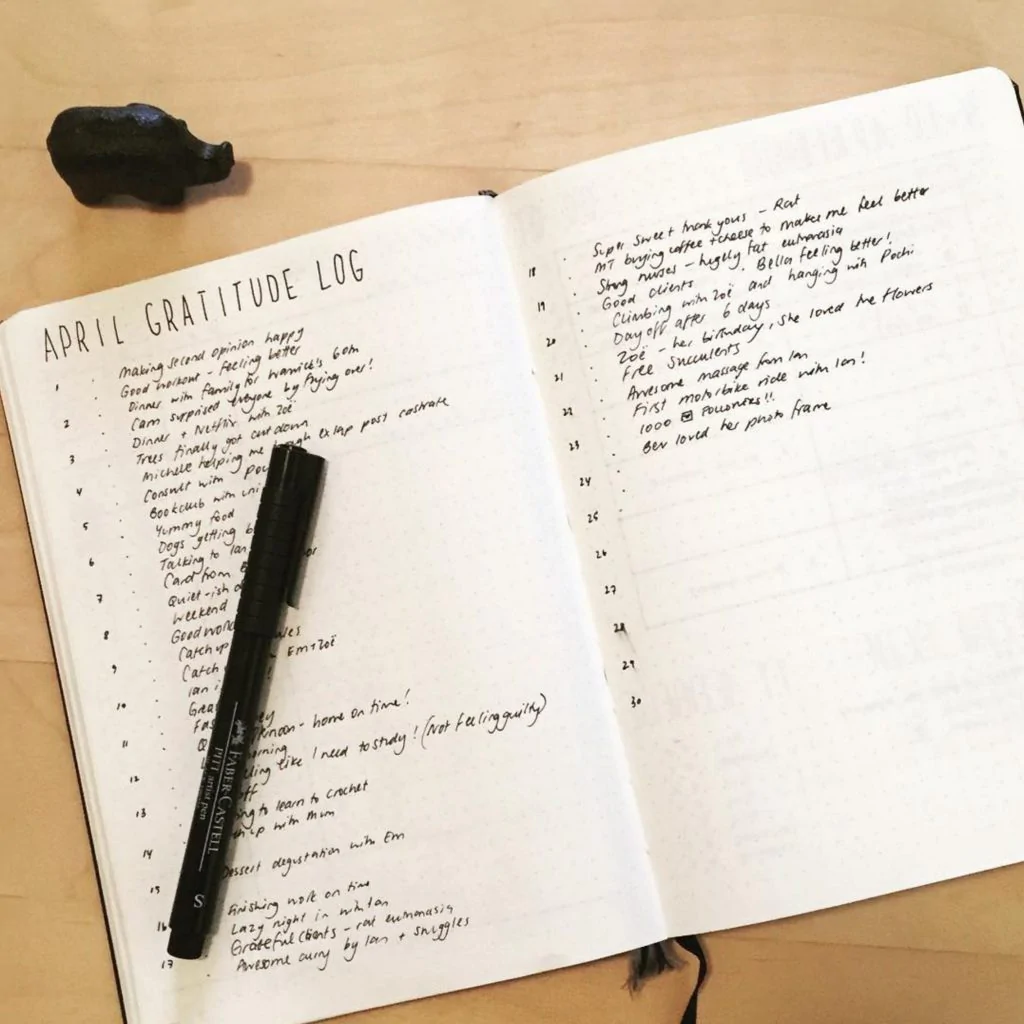I often ask my clients to start keeping a Gratitude Journal, and almost all have many questions. Over time I have a set of FAQs and instructions that I have created to help my clients with Gratitude Journaling, and this article presents that in a more organized form.
When you arise in the morning, think of what a precious privilege it is to be alive – to breathe, to think, to enjoy, to love.
– Marcus Aurelius
What is a Gratitude Journal?
A gratitude journal is a tool to regularly record and reflect on things for which you are grateful. In principle, you are reprogramming your brain to focus more on the positive aspects of your life and to develop resilience in the face of adversity. Keeping a gratitude journal is a popular technique in positive psychology – the science of happiness. It’s also known as “counting your blessings” or “three good things.”
As we will note later, the physical format of the gratitude journal can vary a lot, as can the style of recording gratitude. Before we dig into that, let us consider why we should practice gratitude.
What are the benefits of practicing gratitude?
The Happier Human website created a science backed list of benefits of gratitude. They split the benefits into five groups. I have presented a summary but follow the link above to read the details about the benefits of gratitude.
- Emotional benefits
- Makes us happier
- Increases psychological well-being
- Enhances our positive emotions
- Keeps suicidal thoughts at bay
- Social benefits
- Makes more people like you
- Improves our romantic relationship
- Increases our social support
- Strengthens a family in times of crisis
- Personality benefits
- Makes us more optimistic
- Makes us more empathetic and giving
- Reduces materialism
- Career benefits
- Makes us more effective managers
- Improves decision making
- Helps us find meaning and purpose in our work
- Reduces employee iteration
- Health benefits
- Reduces depressive symptoms
- Reduces elevated blood pressure (Hypertension)
- Improves sleep
- Motivates you for physical exercise
- Improves overall physical well-being
In addition, practicing gratitude regularly has been shown to aid recovery from depression, substance abuse, and coronary health events. Admittedly, that is a long list, and when I first came across it, I was a bit skeptical but reading through the research showed that some pretty solid and well-documented evidence backs it. I suggest you read some of those for yourself.
Gratitude Journal: How To
A gratitude journal is easy to start: just record the things you are grateful for each day in writing (or typing). Use a piece of paper, a journal, a diary, or a notebook. If you’d instead go digital, you can do it using a word document or take it even farther by using an app. However, there are a few decisions that you can make right at the beginning that you can take to ensure you get the maximum benefits out of it.
Choose a format – physical or digital
When you choose to have a physical journal, there are a couple of writing styles that you can adopt. For example, you can write a sentence or a paragraph each day. In addition, there is a simple and just as effective style of gratitude journaling that you can use called Gratitude Bullet Journal. Here you create a bullet list of things you are grateful for as a bullet list in one big block per month. You can buy ready-made gratitude journals online or download free printable gratitude journal templates.

Please don’t be hesitant to use your creativity; embellishing your journal, giving it a personal touch, or adding other style flourishes can all help you stay committed. Do whatever suits you—this journal is meant solely for you!
If you want to go the digital way, then there are a plethora of apps available for you. Here are links to some of them that you can try. They are available for both iOS and Android. Almost all have a free version to try. I would also encourage you to explore more on the app store but only go with apps that have good reviews, have been around for some time, and allow you to export your journal in some format that is readily accessible. You don’t want to be stuck with a lousy app or those that disappear without an option to port your work over to something different.
Here are four apps that I have tried myself
- Gratitude – Happiness Journal
- Presently – A Gratitude Journal
- Delightful: Gratitude Journal
- Reflectly – Journal and AI Diary
Tips to get the best out of your gratitude journal
Be mindful of your new “attitude of gratitude” rather than just going through the motions.
Instead of setting a daily minimum of five things to be thankful for, realize that there will be days when you need to give yourself compassion and flexibility.
Do not hold off till the “perfect time.” Writing something first thing in the morning or the last thing in the night is acceptable.
Give details as to why you are thankful for the things you list. This can assist you in determining what matters most to you and what you can do without in your life.
Prioritize writing about people above possessions. So, while being grateful for your car or smartphone is acceptable, your happiness from meaningful connections is probably much greater.
Avoid rushing. Try to take your time when journaling.
Your list should contain surprises. Surprises can elicit stronger feelings than planned activities and are helpful to reflect on when you’re feeling caught in a routine rut.
Don’t write anything negative in your journal. The focus on the positive distinguishes the thankfulness journal from other types of journaling, note-taking, and diary-writing, as we already discussed, so strive to maintain it that way!
The key to a happy life is variety! So make an effort to add as many new items as you can.
Be imaginative, even if you don’t believe you are. Feel like converting your significant other into a single phrase but with a picture? Do it!
Give it a try. Aim for at least three weeks of daily journaling before passing judgment.
How to ensure consistency?
Every night, set aside 15 minutes to write in your thankfulness diary before going to sleep. Then, on your phone, set the alarm to remind you or put it on your calendar. I’ve discovered that it is simpler to write at night, so I may incorporate items from that day for which I am grateful.
Keep your gratitude journal on your bedside so you will see it before bed, and be reminded to write down your gratitude. Your notebook might even take on the form of a sign of appreciation, making you feel grateful even simply by looking at it.
In your Gratitude Journal, you can include as many entries as you choose. However, it’s a good idea to try to list 3–5 things each day for which you are grateful.
The depth of your gratitude journal can vary. Simple things like “family,” “the new book or movie I recently enjoyed,” or “this morning’s food” can very well be used to express gratitude. Your expression of gratitude would be unique to you.
Gratitude Journaling prompts
When you first start, it could be simple to come up with random things to be grateful for, but even with the best intentions to make soul-satisfying lists, you will surely sooner or later have “gratitude block.” This is where journaling prompts can be helpful.
Rather than just a long list, the prompts have been divided into four categories to help you develop more ideas to write.
Relationships
- What is a previous relationship I am appreciative of?
- What traits do I value in a colleague?
- What one thing about my partner do I admire?
- What positive qualities have I acquired from my friend?
- What positive trait have I inherited from my mother?
- What positive trait have I inherited from my father?
- What is it I admire about the staff at the establishments I visit?
- What aspect of my personality do I genuinely value?
- What positive traits do I look for in a role model?
- How can something I think of as a weakness also be a strength?
What happened today?
- What am I enthusiastic about today?
- What opportunity do I currently have that other people don’t that I can value?
- What one thing—that I can change—would make today better?
- What skills have I improved upon since yesterday?
- What aspects of today’s weather can I genuinely appreciate?
- What is one part of my health that I value?
- What good can I discover in something I expect to suck today?
- What do I love most about my current set of professional abilities?
- What aspects of my financial condition can I appreciate or accept?
- What positive aspects of my appearance do I enjoy today?
Something from yesterday
- What positive events occurred during the day?
- Which challenge that I overcame me proud of myself?
- What about my previous employment did I like?
- What about my early years do I admire?
- What is a negative experience from the past that I can now learn from?
- What lessons from school do I appreciate having learned?
- What do my forefathers deserve praise for that helped me lead the life I do?
- What about the food I had today—or didn’t—do I value?
- What was the most entertaining thing I saw yesterday?
- What fragrance did I notice yesterday that I liked?
Things simple or small
- Pick a favorite item. What about it do you love?
- What features of my house do I appreciate?
- What qualities of my city do I appreciate?
- What aspects of my home nation do I appreciate?
- What do I like best about the eateries I go to?
- What is one article of apparel that I really like?
- What qualities of the music that I listen to do I love
- What is one aspect of my physique that I appreciate?
- Which foods do I genuinely enjoy, and why?
- What kind of artwork do I understand, and why?
Conclusion
Starting a new habit can be challenging, especially if the habit has the potential to elicit strong emotions. Don’t be scared if you initially find it a challenging, demanding, or intensely emotional experience. You will eventually come to understand the wisdom of your emotions and thoughts. If you want to talk more about this topic let us have a virtual coffee

I help IT executives overcome anxiety, overwhelm and procrastination, unleashing their potential using 1:1 CBT sessions | Assertiveness Training | Burn-out Prevention | Beat Perfectionism | Crush Imposter Syndrome

Pingback: What is Cognitive Journaling? Using the ABC model in your daily writing. - Rational Redo